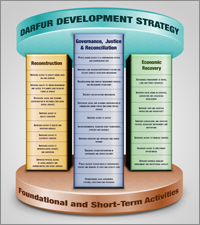You are here
Developing Darfur: A Recovery and Reconstruction Strategy
 |
| Photo by Albert Gonzalez Farran - UNAMID |
Developing Darfur: A Recovery and Reconstruction Strategy
(6.8 MB) click to download
The Doha Document for Peace in Darfur (DDPD) invigorates the peace process and lays the groundwork for a stable, peaceful, and prosperous Darfur. Emanating from Article 32 of the DDPD, the Darfur Joint Assessment Mission (DJAM) was completed in November 2012. Based on the priorities identified by the mission, a Developing Darfur: A Recovery and Reconstruction Strategy has been developed. It provides a sequenced strategy to initiate the recovery-focused objectives articulated within the DDPD. Mindful of past hurdles in the peace process and that the root-causes of the crisis have not been addressed by meaningful development, despite almost ten years of international humanitarian assistance, the strategic occasion presented by the DJAM is undeniable.
Darfur’s recovery is not without challenges. In addition to the massive conflict-driven disruption of Darfur’s economy over the last nine years, Sudan’s economy now also faces difficult hurdles. Donor support to recovery and development based on the needs assessed by the DJAM is therefore required to accelerate implementation of the DDPD.
In order to ensure a sound investment, the DJAM has incorporated lessons learnt from prior assessments and funding appeals; ones hindered by either a lack of security and/or funding. The focus here is therefore two-fold. First, to begin the process with incremental, realistic steps: both to provide an expedient “peace dividend” for Darfuris and to create trust among local communities and firm secure, early, milestones on the road to recovery. Second, to make the transition from relief-orientated, humanitarian aid patterns to more durable and lasting, development assistance. The needs and priorities identified through the DJAM aim to increase the capacity and responsibility, including assuming fiscal oversight and management, of Darfuris and the local and federal governments that serve them.
Three priority areas of Governance, Justice and Reconciliation, Reconstruction and Economic Recovery have emerged as overall focus areas from the DJAM assessment. These integrate the specific needs and priorities identified by the ten thematic working groups through the state- and locality-level consultative workshops in September and federal consultations in October.
- Governance, Justice and Reconciliation - Improve governance at Regional, State and Locality level, streamline budget and fiscal management structures; Review and enhance rule of law institutions and mechanisms; enhance peace and security in the region; establish a culture of transparency and accountability.
- Reconstruction – enhance access to basic social services, including health, nutrition, water and education; meet the immediate infrastructure development requirements and assess future needs; properly address the return, reintegration and/or urbanisation of individuals
- Economic Recovery – facilitate improvement of agriculture, livestock and rural-based livelihoods; oversight and management of natural resources; development of the private sector.
|
Click to enlarge |
| Darfur Development Strategy |
Executive Summary (Click to download)


.jpg)
.jpg)